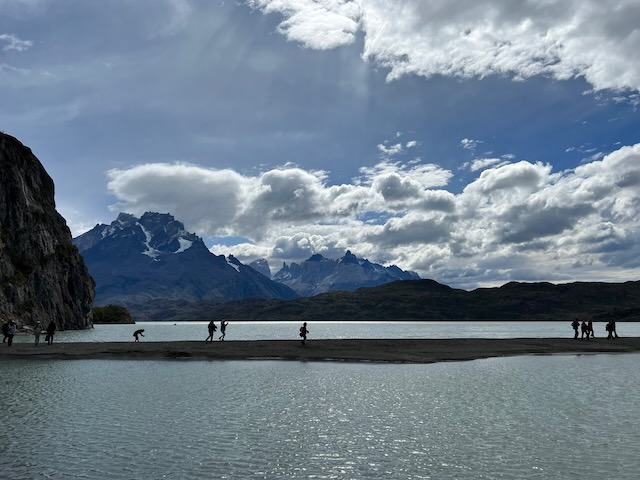We are in Chile. The crossing from Argentina was classic: the Chilean border officer’s computer broke down so we stood outside in cold weather for well over an hour together with other en route tourists as working equipment was brought in from somewhere. And then we drove over large swathes of shrub-covered steppe plains until we are turn a corner and see the incredible Torres Del Paine mountaintops which dominate the landscape.
I previously wrote in error about the geology in these parts but am slowly becoming more educated. We are not actually in the Andres, which are sedimentary mountains formed through the uplifting of tectonic plates, but in a separate massif formed of igneous rock from magma as well as metamorphosed rock created by pressure. The result is a startling black and white mountain: black sedimentary rock atop white granite.
We make several scenic stops on the way to our estancia where we will stay tonight as the view is fairly clear today and the “horns” which make up the iconic image of Torres Del Paine are visible.
Our estancia for the night, Tercera Barranca, is a delight. A warm homey living room with bedrooms with views of the mountains or surrounding fields. Bright happy dogs and cats. We see the cowhand running the horses back to the stable at night and at another time we see the local herd of cattle moving near the farm. Our rooms are cold at night but the sunrise is wonderful and our room heats up when the radiator begins to work about 6 am. Food at the dining room is very expensive, not unexpectedly given how far away it is necessary to travel for any provisions.
Our guide and minibus meet us for a full day of touring the area, including a 5 mile hike in severe wind, observing guanacos, both alive and their skeletal remains, along our path. At the ridge top, along a narrow trail strewn with lose stones and bordered by immense boulders covered with visible ocean conglomerate, is a cave. And on the cave walls are a 6500 year old drawing and handprint from the original inhabitants of this area. It is hard to believe humankind could exist in these conditions for long periods of time — and this is summer.
Among our additional stops is a furious waterfall and other locations with impressive views of the Torres, each one a slightly different perspective with a different cloud formation and areas of visibility. Our photos are endless as each turn of our car bring us to another place where we all take out our camera phones and begin to click new photos and videos.
The last part of the park we explored on our last day here is Lago Grey Lake. This required walking along a very gravel sand bar over a mile with intense tail winds whipping behind us, sometimes making the traverse difficult along the narrow muddy path between the lake and the rocks. We boarded the warm ship and sat inside to eat our lunches while the sun disappeared behind clouds and covered the high mountains. This was the first poor weather we have had. We cruise near the three tongues of the Grey glacier which was deep icy blue but also covered with the dirt of centuries as global warming now takes its toll. It was an opportunity to sit inside for some of us and enjoy the scenery move by. We met a group of women hikers who just returned from 5 days of trekking along the “W” route, the well-known mountaineer’s hike through these mountains. Their all-women group, called Pumpalcerro, is out of Santiago and they are determined to roam together on the world’s great mountain walks. An interesting interaction and we told them if we were a little younger we would join them on their jaunts although we did turn down their invitation to party all night at a discotheque.
Our last night in Patagonia is in Puerto Natales, by an inlet of the Pacific Ocean, where a bevy of black-necked swans were enjoying their evening swim. We all had dinner at a seafood restaurant and explored the 5-6 blocks that comprise this southern Chile town. Tomorrow we leave for Santiago.









